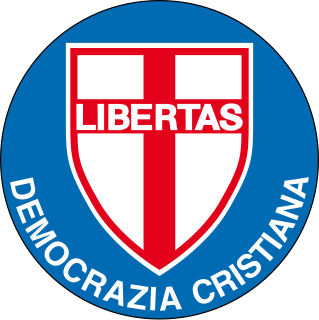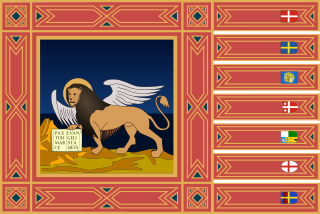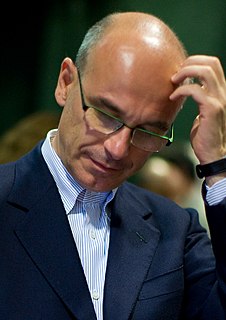 |
|---|
| This article is part of a series on the politics and government of Lombardy |
|
The Lombard regional election of 1970 took place on 7 June 1970. It was the first-ever regional election.
 |
|---|
| This article is part of a series on the politics and government of Lombardy |
|
The Lombard regional election of 1970 took place on 7 June 1970. It was the first-ever regional election.
Election was held under proportional representation with provincial constituencies where the largest remainder method with a Droop quota was used. To ensure more proportionality, remained votes and seats were transferred at regional level and calculated at-large.
Proportional representation (PR) characterizes electoral systems in which divisions in an electorate are reflected proportionately in the elected body. If n% of the electorate support a particular political party, then roughly n% of seats will be won by that party. The essence of such systems is that all votes contribute to the result - not just a plurality, or a bare majority. The most prevalent forms of proportional representation all require the use of multiple-member voting districts, as it is not possible to fill a single seat in a proportional manner. In fact, the implementations of PR that achieve the highest levels of proportionality tend to include districts with large numbers of seats.
The largest remainder method is one way of allocating seats proportionally for representative assemblies with party list voting systems. It contrasts with various divisor methods.
The Droop quota is the quota most commonly used in elections held under the single transferable vote (STV) system. It is also sometimes used in elections held under the largest remainder method of party-list proportional representation. In an STV election the quota is the minimum number of votes a candidate must receive in order to be elected. Any votes a candidate receives above the quota are transferred to another candidate. The Droop quota was devised in 1868 by the English lawyer and mathematician Henry Richmond Droop (1831–1884) as a replacement for the earlier Hare quota.
The Christian Democracy party was by far the largest and christian-democrat Piero Bassetti was able to form a strong center-left government with the support of the PSI, the PSDI and the PRI. Bassetti was replaced by Cesare Golfari in 1974.

Christian Democracy was a Christian democratic political party in Italy.
The Organic Centre-left, was a coalition of four Italian political parties that formed governments throughout the 1960s and the middle 1970s.

The Italian Socialist Party was a socialist and later social-democratic political party in Italy. Founded in Genoa in 1892, the PSI dominated the Italian left until after World War II, when it was eclipsed in status by the Italian Communist Party. The Socialists came to special prominence in the 1980s, when their leader Bettino Craxi, who had severed the residual ties with the Soviet Union and re-branded the party as liberal-socialist, served as Prime Minister (1983–1987). The PSI was disbanded in 1994 as a result of the Tangentopoli scandals. Prior to World War I, future dictator Benito Mussolini was a member of the PSI.
Summary of the 7 June 1970 Lombard regional election
 | |||||
| Party | Votes | % | Seats | ||
|---|---|---|---|---|---|
| Christian Democracy | DC | 2,138,141 | 40.90 | 36 | |
| Italian Communist Party | PCI | 1,210,068 | 23.14 | 19 | |
| Italian Socialist Party | PSI | 648,696 | 12.41 | 9 | |
| Unified Socialist Party | PSU | 376,436 | 7.20 | 5 | |
| Italian Liberal Party | PLI | 310,324 | 5.94 | 4 | |
| Italian Social Movement | MSI | 195,791 | 3.74 | 3 | |
| Italian Socialist Party of Proletarian Unity | PSIUP | 188,585 | 3.61 | 2 | |
| Italian Republican Party | PRI | 125,767 | 2.41 | 2 | |
| Italian Democratic Party of Monarchist Unity | PDIUM | 31,119 | 0.60 | 0 | |
| Italian Autonomist Union | UAI | 3,389 | 0.06 | 0 | |
| Total valid votes | 5,228,316 | 80 | |||
| Blank votes | 161,676 | ||||
| Invalid votes (blank included) | 225,720 | ||||
| Total | 5,453,931 | ||||
| Registered voters & turnout | 5,710,352 | 95.51 | |||
Source: Ministry of the Interior
| Province | DC | PCI | PSI | PSU | PLI | MSI | PSIUP | PRI | Total |
|---|---|---|---|---|---|---|---|---|---|
| Milan | 12 | 9 | 4 | 3 | 3 | 2 | 1 | 1 | 35 |
| Brescia | 5 | 2 | 1 | 1 | - | 1 | 1 | - | 11 |
| Bergamo | 5 | 1 | 1 | 1 | - | - | - | - | 8 |
| Como | 4 | 1 | 1 | - | 1 | - | - | - | 7 |
| Varese | 3 | 1 | 1 | - | - | - | - | 1 | 6 |
| Mantua | 2 | 2 | 1 | - | - | - | - | - | 5 |
| Pavia | 2 | 2 | - | - | - | - | - | - | 4 |
| Cremona | 2 | 1 | - | - | - | - | - | - | 3 |
| Sondrio | 1 | - | - | - | - | - | - | - | 1 |
| Total | 36 | 19 | 9 | 5 | 4 | 3 | 2 | 2 | 80 |
The additional member system (AMS), also known as mixed-member proportional representation (MMP) outside the United Kingdom, is a mixed electoral system with one tier of single-member district representatives, and another tier of ‘additional members’ elected to make the overall election results more proportional.

The National Assembly is the lower house of the Parliament of South Africa, located in Cape Town, Western Cape Province. It consists of four hundred members who are elected every five years using a party-list proportional representation system where half of the members are elected proportionally from 9 provincial lists and the remaining half from national lists so as to restore proportionality.

The Politics of Veneto, a Region of Italy takes place in a framework of a semi-presidential representative democracy, whereby the President is the head of government, and of a pluriform multi-party system. Executive power is exercised by the Regional Government. Legislative power is vested in both the government and the Regional Council.

This page gathers the results of elections in Veneto.

The Sardinian regional election of 2004 took place on 12–13 June 2004.

The Politics of Lombardy, Italy, takes place in a framework of a semi-presidential representative democracy, whereby the President of the Region is the head of government, and of a pluriform multi-party system. Legislative power is vested in the Regional Council of Lombardy, while executive power is exercised by the Regional Government led by the President, who is directly elected by the people. The current Statute, which regulates the functioning of the regional institutions, has been in force since 2008.

The Lombard regional election of 1995 took place on 23 April 1995. The 6th term of the Regional Council was chosen.

The Lombard regional election of 1990 took place on 6 May 1990. The 5th term of the Regional Council was chosen.

The Lombard regional election of 1985 took place on 12 May 1985. The 4th term of the Regional Council was chosen.

The Lombard regional election of 1980 took place on 8 June 1980. The 3rd term of the Regional Council was chosen.

The Lombard regional election of 1975 took place on 15 June 1975. The 2nd term of the Regional Council was chosen.

The Tuscan regional election of 1970 took place on 7 June 1970. It was the first-ever regional election.

The Sardinian regional election of 1953 for the Second Council took place on 14 June 1953.

The Sicilian regional election of 1951 took place on 3 June 1951 to select the Second Sicilian Parliament.

The Sardinian regional election of 2009 took place on 15–16 February 2009.

The Italian regional elections of 1970 were held on June 7. Even if the regional system was conceived by the Italian Constitution in 1948, the five autonomous regions were the sole to be immediately established. The fifteen ordinary regions were indeed created in 1970 with the first elections.

The Italian regional elections of 1975 were held on June 15. The fifteen ordinary regions, created in 1970, elected their second assemblies. Following the 1971 census, Piedmont, Veneto and Latium had ten more seats each.

The Italian regional elections of 1980 were held on June 8. The fifteen ordinary regions, created in 1970, elected their third assemblies.

The Italian regional elections of 1985 were held on May 12. The fifteen ordinary regions, created in 1970, elected their fourth assemblies.

The Italian regional elections of 1990 were held on May 16. The fifteen ordinary regions, created in 1970, elected their fifth assemblies.